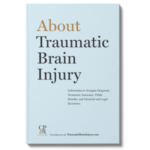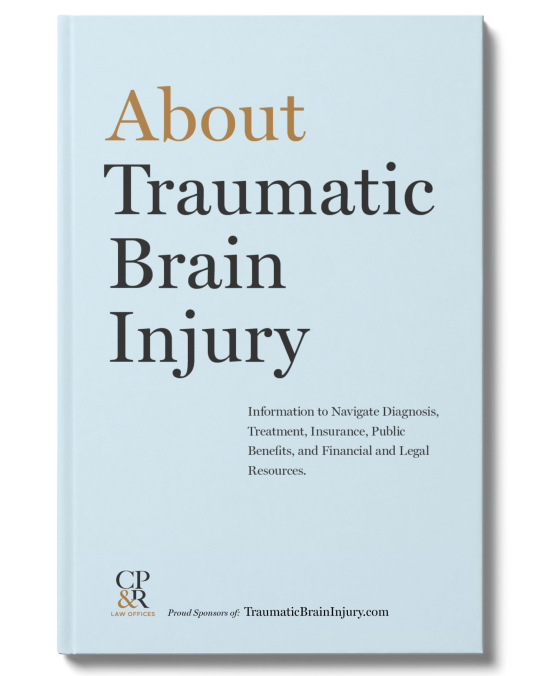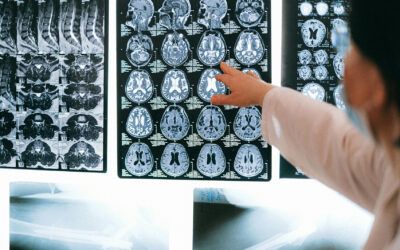A Parents’ Guide to Understanding Traumatic Brain Injury at Birth
Complications during labor and delivery can cause a variety of brain injuries in newborns — some of which can last a lifetime. Here’s what you need to know about risk factors, diagnoses, treatments, and how to seek help.
Want to learn more About Traumatic Brain Injury?

The overwhelming joy of welcoming a new child into the world can quickly be overshadowed by the heart-wrenching realization that your child has suffered a traumatic brain injury at birth. In an instant, joy and anticipation turns to profound concern for the child’s life, health, and future.
This marks the beginning of a journey that begins with countless questions. Recognizing the immense challenges ahead, parents find themselves navigating an intricate maze of medical resources, seeking specialized pediatric neurologists and rehabilitation specialists, home health care, surgeries, medications, equipment, treatment, therapies, and more. They must also learn the intricacies of insurance coverage and government benefits. As the child grows, they may need to explore educational resources tailored for their child’s special needs.

And all the while, they must be prepared to advocate, with lawyers if necessary, for their child. There will be lingering questions: Why was my child injured at birth, and who will pay for the lifetime of care required? This journey, though daunting, is guided by unwavering love, resilience, and a quest for the best possible future for their child.
Want to learn more about how to navigate a TBI at birth, including real-world legal case studies?
The Most Common Types and Causes of Traumatic Brain Injury at Birth
Traumatic brain injuries at or immediately after birth can occur due to various factors, which can be related to complications during labor and delivery. For example, if the baby is deprived of oxygen. Hypoxic-ischemic encephalopathy (HIE) is a dangerous condition that is caused by a lack of oxygen and blood flow to the brain. Hypoxia is oxygen deficiency; ischemia is a restriction of the blood flow to the brain; and when damage to brain cells results, it is encephalopathy. In severe cases HIE can cause permanent brain damage, CP, and death.
There are several reasons why blood flow or oxygen delivery to the brain can occur, including problems with blood flow to and from the placenta, abnormal fetal position, placental bleeding or tearing, or infection. As these are all known risks of labor and delivery, it is the duty of the medical team to continuously monitor both the mother and unborn baby during labor for signs, symptoms, and indications of fetal distress and HIE.
The purpose of monitoring the mother and unborn baby during labor is to alert the care team to issues and intervene in a timely manner if, as, and when there are concerns about the baby’s health or life. Interventions could be as simple as administering oxygen, repositioning the mother, or could lead to an emergency delivery by surgery (Cesarean section or C-section). Timely interventions can prevent brain damage.
To evaluate whether the baby is under stress and at risk for HIE, the medical team uses electronic fetal monitoring (EFM) during labor along with other signs and symptoms, such as the baby’s movement and the overall progress of labor. EFM is a continuous test that records the baby’s heart rate and the mother’s contractions; it becomes a part of the medical chart.
EFM is typically performed externally. Elastic strips are used to secure two measuring devices to the mother’s abdomen. An ultrasound device is also positioned over the mother’s abdomen, and this is used to measure the unborn baby’s heart rate. A pressure gauge placed at the top of the mother’s abdomen is used to measure the frequency of the mother’s contractions.
Internal monitoring can occur after the uterine sack ruptures (the “water breaking”). During internal monitoring, a small electrode is placed on the baby’s scalp in utero to get a more accurate tracing of the fetal heartbeat.
EFM is universally used in the United States and around the world, and, in conjunction with other signs and symptoms, provides the medical team with critical information about the baby’s condition and whether the baby is in distress, whether there is sufficient oxygenation, and whether the baby is at risk for HIE, brain damage, and CP.
An abnormal fetal heart rate during labor and delivery, an abnormal neurological exam after birth (the Apgar score, discussed below), and an abnormal umbilical artery blood gas result (an analysis of blood from the umbilical cord) are consistent with an acute intrapartum hypoxic-ischemic event that occurred during labor and delivery and which can cause brain damage, HIE, and CP. When those facts are present, an experienced lawyer should carefully review the facts and circumstances.
By closely monitoring the progression of labor, the movement of the child, the baby’s heart rate, and the mother’s contractions, the medical team has, or should have, the information necessary to make appropriate decisions regarding the timing of delivery to avoid HIE, brain damage, and CP.
Hypoxia can also occur if there are issues with the umbilical cord, such as cord compression or a prolapsed cord that restricts blood flow to the baby. Conditions such as uterine rupture or maternal infections can further complicate the delivery process, increasing the risk of brain damage.
Premature birth is another significant risk factor, as infants born prematurely are more vulnerable to various complications, including intraventricular hemorrhage, which is a type of brain bleeding. Asphyxia can also occur if there are signs of fetal distress that go unaddressed, potentially impacting the baby’s neurological development. It is critically important for healthcare practitioners to recognize these risk factors, understand and make appropriate interventions during and immediately after childbirth to prevent brain injury at birth.
When an infant suffers a brain injury it may have been caused by medical negligence or malpractice of the medical practitioners attending the birth of the child. These practitioners have a duty to both of their patients, the mother and the baby. The only way to determine whether the injury to the infant was caused by medical negligence is by a detailed and exhaustive investigation of the medical record by experienced brain injury lawyers who do this work, assisted by expert physicians who carefully review the record and the facts of the delivery.
Let’s look at some common causes of traumatic brain injury at birth:
Birth Asphyxia
This includes a lack of proper oxygen (hypoxia) and lack of proper blood flow to the brain (ischemia). In severe cases, these conditions can lead to hypoxic-ischemic encephalopathy (HIE), cerebral palsy, or even death.
Brain Bleeds
Bleeding in the brain — known as an “intracranial hemorrhage” — at birth can range from mild to life-threatening and can be caused by a variety of factors, including premature and breech deliveries; extended periods of pressure on the infant’s brain in the pelvis or birth canal; birth asphyxia (see above); and more.
The most common types of TBI caused by brain bleeds at birth include:
Importance of Knowing the Cause of Brain Injury for Parents
Research regarding the parents of children with CP confirms that it is important for parents to understand the cause of their child’s injury, that parents have strong emotions about the causes of their child’s injuries, and that parents’ emotions affect the action that they take in relation to their child’s injury.
In their anger, sadness, and grief, some parents with children with catastrophic injuries sometimes blame others. Some parents believe the cause is their own failure to protect their child, and they feel guilt. Parents have lived with these feelings, often pent up, for years. Parents routinely consult attorneys years after the injury to their child, looking for answers to questions that were never investigated at the time of the injury. Sometimes, due to minor tolling statutes, parents or guardians can still file claims to provide financial assistance for children. In some cases, the investigation by experienced lawyers, the expert review, or the lawsuit itself provides comfort and closure.
Symptoms of Brain Injury at Birth
In some children, signs and symptoms of brain appear minutes or hours after a baby is born, but in others, they can take months or years to appear and be diagnosed. It’s vital to know what to look for, and to seek medical help as soon as you see potential signs or symptoms so your child can get prompt treatment and obtain the best possible outcome.
Diagnosis and Treatment of Traumatic Brain Injuries at Birth
There are a variety of methods used by healthcare professionals to obtain an accurate diagnosis of a brain injury in an infant, including both physical and neurological clinical evaluations, as well as imaging such as CT scans or MRIs to assess the extent of the injury.
The Apgar score is a crucial assessment tool used immediately after birth to evaluate a newborn’s overall health and vital functions. This quick, systematic scoring system measures five criteria – appearance, pulse, grimace response, activity, and respiration – each scored from 0 to 2, resulting in a total score ranging from 0 to 10. A high Apgar score typically indicates that the newborn is in good health and adapting well to life outside the womb, while a low score can signal potential complications, including oxygen deprivation or distress during delivery, which may be linked to a higher risk of brain injury.
When a newborn receives a low Apgar score, it raises immediate concerns for healthcare providers and parents alike, as it may be an early indicator of neurological impairment or other medical issues. For instance, a score of 4 or lower at one minute after birth often prompts further evaluation for possible brain injury, particularly in cases of asphyxia or prolonged labor. The relationship between the Apgar score and brain injury underscores the importance of prompt medical assessment and intervention; understanding these scores can help parents comprehend the immediate health status of their child and inform necessary next steps in monitoring and treatment, should any complications arise. In essence, while the Apgar score provides a preliminary snapshot of a newborn’s well-being, it also serves as a critical tool in identifying those who may require closer observation and multidisciplinary care to address potential long-term consequences of any injuries sustained during birth.
Whenever your healthcare team suspects brain injury they may evaluate the child using Modified Glasgow Coma Scale (GCS) for Infants and Children. It is a valuable tool used by medical professionals to assess the level of consciousness and neurological functioning. Tailored for the developmental needs of infants and children, this scale evaluates three criteria: eye opening, verbal response, and motor response. Each criterion is scored separately, allowing for a comprehensive evaluation of the child’s neurological status. An important aspect of the modified GCS is its adaptability, as the verbal response component is adjusted to make it effective for assessing children who are not able to respond verbally in the same way as an adult.
Sources: UW Medicine, Cleveland Clinic, and National Center for Biotechnology Information
The scoring system works by assigning specific points to each of the three criteria. Eye opening can score between 1 (no response) and 4 (spontaneous opening). The verbal response is scored from 1 (no verbal response) to 5 (appropriate words or cries), depending on the child’s ability to vocalize or express distress. Lastly, the motor response scores between 1 (no movement) and 6 (obeys commands). The total GCS score can range from 3 to 15, with lower scores indicating more severe impairment of consciousness and a higher likelihood of significant brain injury.
By assessing the aggregate score and identifying potential deficits in these three areas, healthcare providers can make informed decisions regarding the urgency of interventions, further diagnostic evaluations, and optimal management strategies for infants and children showing signs of brain damage, and may include some or all the following:
- Immediate Care — The priority is always ensuring the baby is breathing and maintaining blood flow to the brain.
- Medications — A variety of treatments can help manage symptoms such as pain, seizures, or spasticity.
- Hospitalization — In severe cases, monitoring and potential surgical intervention may be required.
- Short- and Long-Term Rehabilitation — Physical, occupational, and speech therapy can help address any deficits resulting from the injury. In the most severe cases, lifelong in-patient or in-home care is required.
- Monitoring — Regular check-ups allow caregivers to monitor the infant’s recovery and address any ongoing issues.
- Support — Access to support services can help both your child and your family cope with any long-term TBI impacts.
Finally, it is important to know that not all birth injuries are diagnosed at birth. For example, Cerebral palsy (CP) can be diagnosed at various ages, and many children may not receive a definitive diagnosis until they are 2 to 3 years old, although some signs can be observed earlier. According to research from the Centers for Disease Control and Prevention (CDC), parents often notice developmental delays or atypical movements in their children within the first few months to first year of life. Nonetheless, formal diagnoses typically occur later, as healthcare providers wait for definitive patterns of development to emerge before making a diagnosis.
Supporting your child after a brain injury starts here. Get the free book for more information on diagnosis, care, and resources.
What Is the Long-Term Outlook for a Baby After Suffering Brain Injury at Birth?
The long-term prognosis for a baby who has suffered a brain injury at birth can vary significantly depending on several factors, including the type and severity of the injury, the region of the brain affected, the timing and effectiveness of the interventions provided, and the overall health of the infant.
Potential Long-Term Outcomes for a Baby After Suffering Traumatic Brain Injury at Birth
Many infants who experience significant brain injuries at birth may go on to develop cerebral palsy, which affects movement and coordination. The severity of CP can range from mild to severe, impacting the child’s mobility, posture, and daily functioning.
Brain injuries can lead to cognitive impairments and developmental delays. Children may experience difficulties in areas such as learning, attention, and behavior, and these challenges can manifest as they grow older.
Some infants may develop epilepsy or seizure disorders as a result of brain injury. Seizures can vary in frequency and severity, and management may require medication and ongoing medical care.
Depending on the areas of the brain affected, children may experience delays in speech and language development. Speech therapy can be beneficial in addressing these issues.
Children who have suffered brain injuries may also experience difficulties with sensory processing, which can affect how they respond to sensory stimuli and interact with their environment.
Brain injuries may impact a child’s social skills and emotional development. These children may require support in developing healthy social relationships and managing emotions.
The overall prognosis for quality of life can vary widely. Some children with mild brain injuries may grow up to lead relatively normal lives, while others with more severe injuries may require lifelong care and support.
Early interventions, such as physical therapy, occupational therapy, and speech therapy, can significantly improve outcomes and help children reach their developmental milestones. Regular follow-up with healthcare providers, including neurologists, pediatricians, and therapists, is crucial in managing any ongoing challenges.
It is essential for parents and caregivers to seek support and resources to navigate the complexities of caring for a child with a history of brain injury. Prognosis is highly individualized.
Financial Impact of a Traumatic Brain Injury at Birth
An individual family’s financial costs following a brain injury diagnosis are variable and depend upon many factors, but it may amount to millions of dollars, which includes benefits paid by private insurance, government insurance, benefits, and services.
According to the CDC, the estimated lifetime costs of medical care in 2003 dollars in the US totaled $51.2 billion for people with intellectual disabilities, $11.5 billion for people with CP, $2.1 billion for people with hearing loss, and $2.5 billion for people with vision impairment.
This is equivalent to approximately $134.7 billion in purchasing power in 2024.
Need help investigating your legal rights related to a traumatic brain injury?
Speak to an experienced brain injury attorney team like Cohen, Placitella & Roth.
For five decades, CPR has successfully represented individuals and families in TBI cases nationwide working with qualified co-counsel.


Get Our Free Traumatic Brain Injury Book
To learn more about Traumatic Brain Injury request our comprehensive book, available for free directly to your inbox



